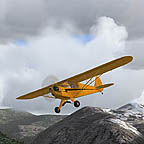
Flight Notes — how to fly the Piper J–3C–65 "Cub"
Touching the Sky — Flying low and slow, a Piper J–3 Cub revives the roots of aviation
The Cub is an airplane much beloved by those who fly it. Introduced in 1938, the J3 made learning to fly accessible to many more people. One estimate states that 75% of American aviators in World War II learned to fly in the Cub. Still popular after more than 60 years, nostalgia and the fact that the airplane is fun to fly have driven J3 prices beyond what could have been imagined in 1938. The next time you attend an air show, look for a row of small yellow airplanes and note the look of pride on the owner's faces; you'll know you've found the Cubs.
The Piper J3 Cub is basic flying: simple airframe, simple panel, and simple engine. A P–51 Mustang it is not, but that doesn't mean you can be complacent when flying the Cub. Like all taildraggers it offers challenges to your skills during takeoff and landing, and it is not the tamest airplane in a stall.
Specifications
| Specifications | U.S. | Metric |
| Maximum Speed | 85 mph 73 knots | 137 km per hour |
| Engine | Continental 65 horsepower air-cooled | |
| Service Ceiling | 11,500 feet | 3,505 meters |
| Maximum Range | 190 miles | 306 km |
| Fuel Capacity | 12 gallons U.S. | 45.4 liters |
| Empty Weight | 680 pounds | 308 kilograms |
| Gross Weight | 1,220 pounds | 553 kilograms |
| Length | 22 feet | 6.7 meters |
| Wingspan | 35 feet | 10.6 meters |
| Height | 6.7 feet | 2 meters |
| Seating | 2 | |
| Useful Load | 540 pounds | 245 kilograms |